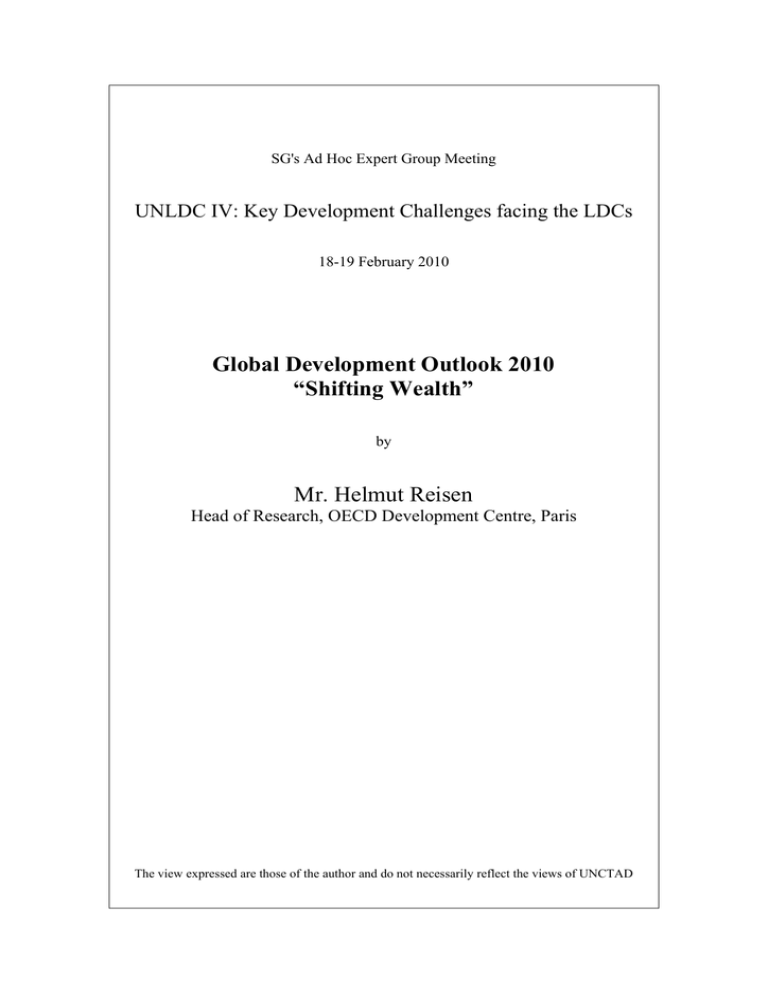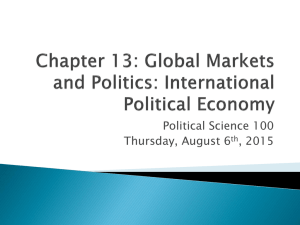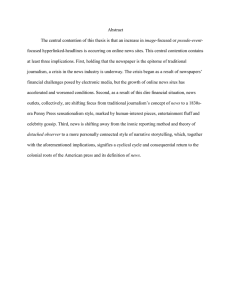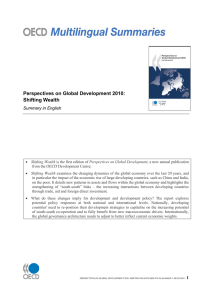Global Development Outlook 2010 “Shifting Wealth” Mr. Helmut Reisen
advertisement

SG's Ad Hoc Expert Group Meeting UNLDC IV: Key Development Challenges facing the LDCs 18-19 February 2010 Global Development Outlook 2010 “Shifting Wealth” by Mr. Helmut Reisen Head of Research, OECD Development Centre, Paris The view expressed are those of the author and do not necessarily reflect the views of UNCTAD UNLDC IV: Key Development challenges facing the LDCs Expert Group Meeting 18th February 2010 Helmut Reisen Head of Research OECD Development Centre Outline Global Development Outlook 2010 “Shifting Wealth” 1. Growth Performance in a 4‐Speed World 2. Implications for Poor Countries 3. Structural Progress in the LDCs “Shifting Wealth”: Growth in a 4‐Speed World Global Development Outlook 2010 Key messages on “Shifting Wealth” • Since 1990, the global centre of economic gravity is shifting, led by sustained growth in China and India, since the 2000s on ‘sugar high’. • Good news for developing countries that directly/indirectly benefit. • Despite strong economic growth & unprecedented poverty reduction globally, progress has been unequal and calls for re‐balancing. • South‐south linkages (goods, capital, people and ideas) increasingly connect emerging and still poor countries. • “Shifting wealth” demands re‐thinking traditional policy prescriptions for international co‐operation and national development policies Global Development Outlook 2010: A useful framework for thinking about development since 1990 The 4‐Speed World • Affluent: High Income GNI/cap • “Convergers”: GDP/cap Growth>twice OECD average • Struggling: GDP/cap Growth<twice OECD average & Middle Income GNI/cap • Poor: GDP/cap Growth<twice OECD average & Low Income GNI/cap The 4-Speed World: 1990s 2000s The 4-Speed World 1990s 2000‐07 1990‐2007 Affluent 34 40 40 Converging 13 69 22 Struggling 65 35 70 Poor 56 26 36 Total 168 170 168 “Shifting Wealth’s” impact on global wages, prices and interest rates Beside the shift in global growth patterns towards convergence, 3 other major developments underpin “Shifting Wealth” • Initial wage shock when global labor force absorbed massive numbers of workers in large converging economies • Converging economies’ vast appetite for raw materials increased fossil energy and industrial metals from 2000, transferring wealth to raw material exporters • Many countries switched from net debtor to net creditor position, indirectly depressing interest rates on US government debt “Shifting Wealth”: Implications for Poor Countries What does Shifting Wealth mean for the Poorest Countries? • Despite the initial wage shock, “Convergers” like China and India are now less competing with the least‐developed countries. • While Raw Material Exporters have benefited, natural resources aren’t the only source of growth in Poor countries • The realigned global economy implies unprecedented opportunity for South‐South Trade, Investment, and Aid China’s exports now more similar to Affluent countries Fu, Kaplinsky and Zhang (2009) • 1989‐1997 the prices of low‐income countries were most affected by Chinese exports • 1998‐2006 middle‐income countries were most affected by China’s export expansion. • Evidence from this study also indicates a price depression effect of China’s exports on high‐income countries in low‐ technology product markets All that glitters is not gold… Resource Rich vs. Resource Poor Countries in Sub-Saharan Africa New Trade Partners South‐South Exports (as a share of total Southern exports) 1990= 25% of Southern exports 2007 = 33% of Southern exports Source: IMF DOTS (2009) Turn to cash-rich emerging partners: DAC donors underdeliver “Shifting Wealth” and Structural Progress in the LDCs What does “Shifting Wealth” mean for Structural Progress in the LDCs? • • Why has their been such a strong bifurcation in the developing world? – manufacturing capacity – technological upgrading Growing Synchronicity between the China and Developing world – LDCs have a stake in debate on global imbalances – Chinese RMB appreciation may not be in Poor Country’s interest Build Up in Manufacturing Capacity has been Uneven Manufacturing Value-Added Per Capita COUNTRY World 1990 $812 1995 $837 1998 $886 2000 $944 2005 $1,014 2007 $1,060 CIS $462 $216 $195 $237 $327 $361 Sub‐Saharan Africa China Latin America North Africa $30 $100 $622 $150 $26 $199 $696 $155 $28 $256 $733 $171 $28 $303 $687 $194 $30 $491 $759 $208 $30 $597 $789 $215 Developing Countries $171 $215 $239 $253 $326 $366 $3,925 $195 $4,238 $222 $4,421 $314 $4,554 $367 Industrialized (excl. CIS) $3,491 $3,658 Asia $117 $170 Source: UNIDO Technological Divide between Convergers & Struggling/Poor Average TFP growth (%), 2000s Only labour force Human capital augmented CB function Affluent Converging Struggling Poor 1.15 3.41 0.34 0.20 1.14 2.83 0.51 0.57 Brazil China India South Africa 1.4 4.4 2.1 1.8 1.4 4.4 2.1 1.8 Source: OECD Development Centre, 2010 Convergence: China’s Impact •Rodrik (2010): 10% nominal effective appreciation of the renminbi would reduce China’s annual per capita growth by 0.86 percentage points. •=> drop of GDP growth to 0.30 percentage points of annual per capita income growth in poor countries (o.86 x 0.354) •Source: B.Hacibedel & H. Reisen, “Global Imbalances, Renminbi Appreciation and Poor‐Country Growth”, OECD Development Centre WP, forthcoming 2010. Table 1. Developing‐Country Growth: Switching to the China Growth Engine Low Income advanced advanced*dummy(20002008) Middle Income 0.134 0.832*** 0.173 0.662*** 1.13 3.40 1.89 4.95 0.289*** -0.916*** 0.281 -0.41** 3.80 -2.85 4.72 -2.35 china china*dummy(2000-2008) -0.128 0.224*** -1.61 5.16 0.354*** 0.217*** 3.85 4.40 obs 432 432 1053 1053 R2 0.36 0.39 0.26 0.29 Potential growth impact of Renminbi appreciation on developing countries Price competition effect Total effect Negative Insignificant Negative Negative Positive Ambiguous Indirect Impact channel growth effect Low‐income countries Middle‐income countries The End Thank you! E-mail: helmut.reisen@oecd.org










